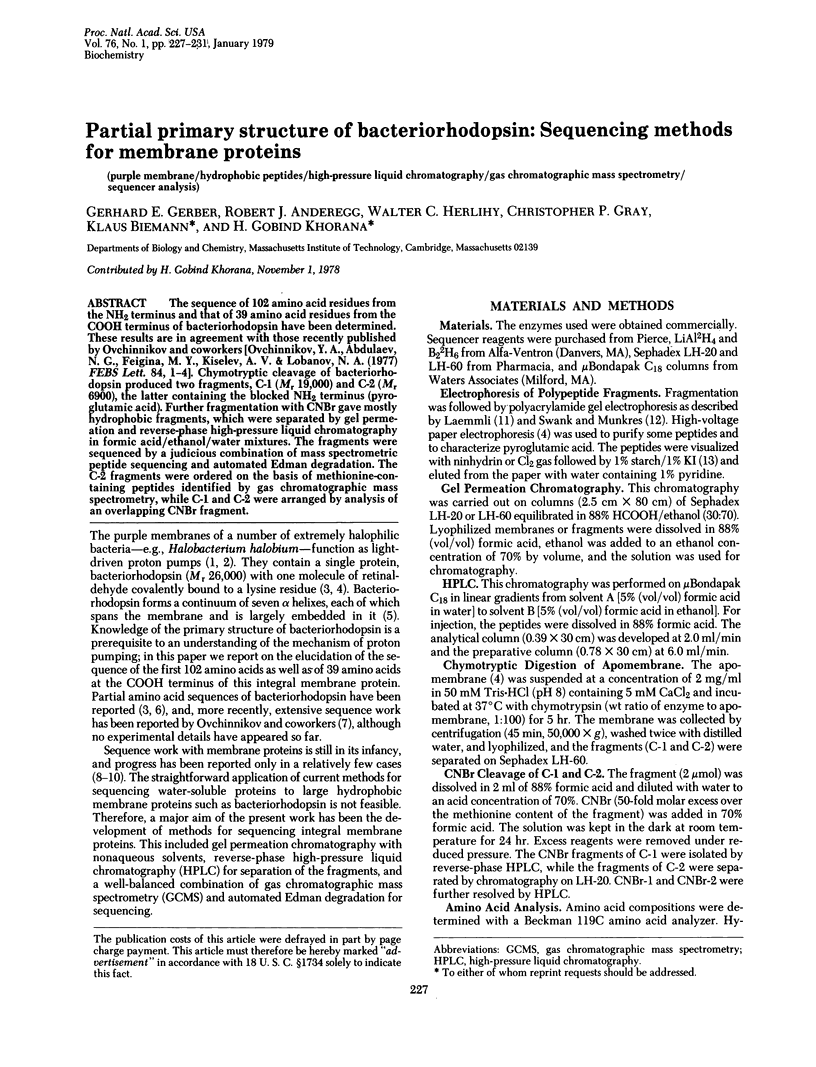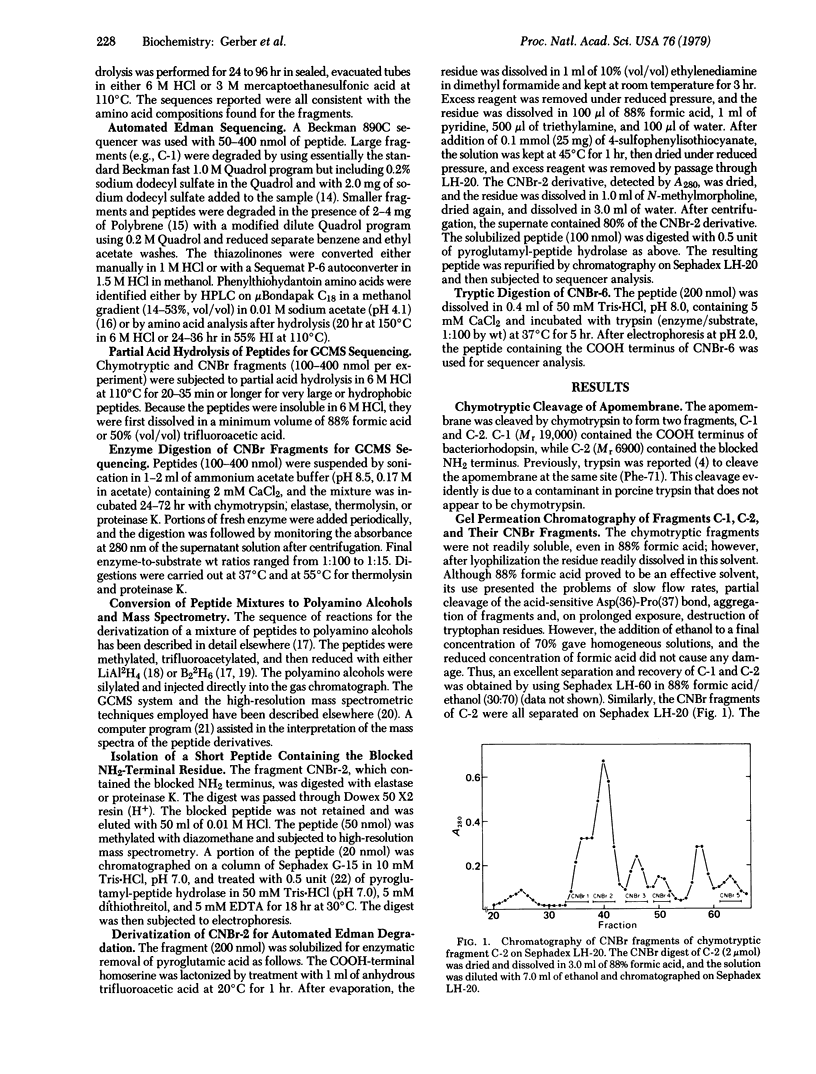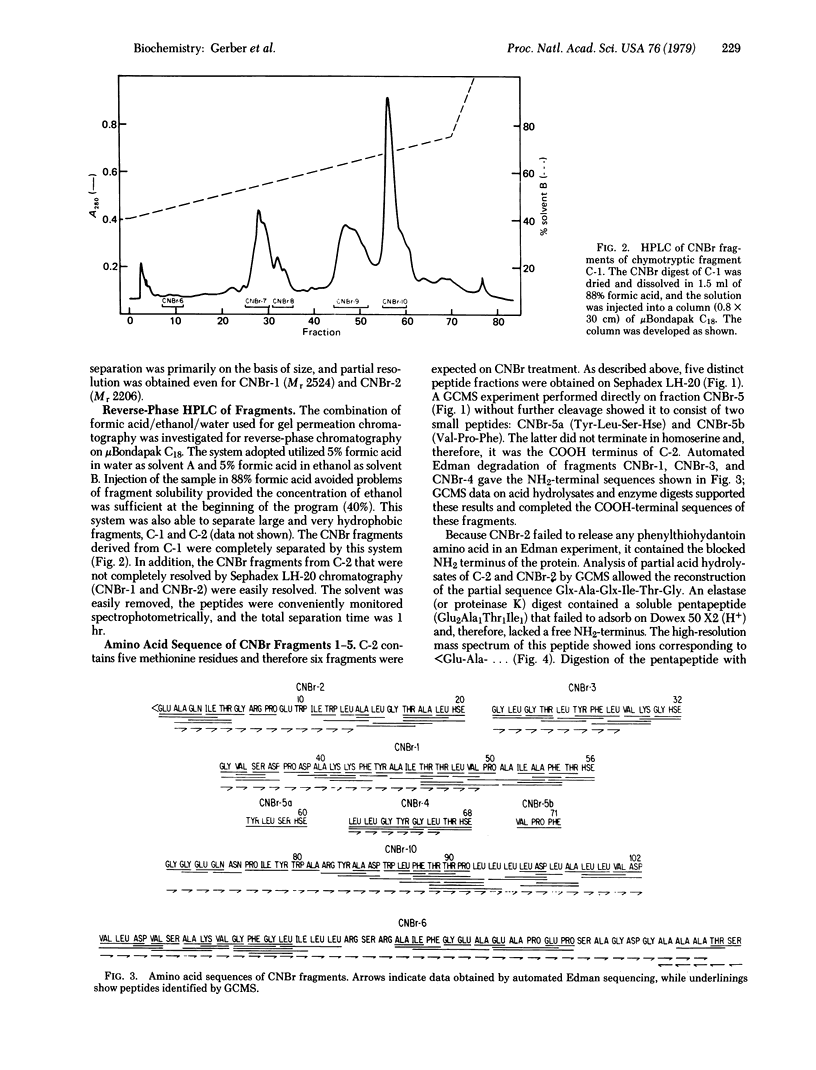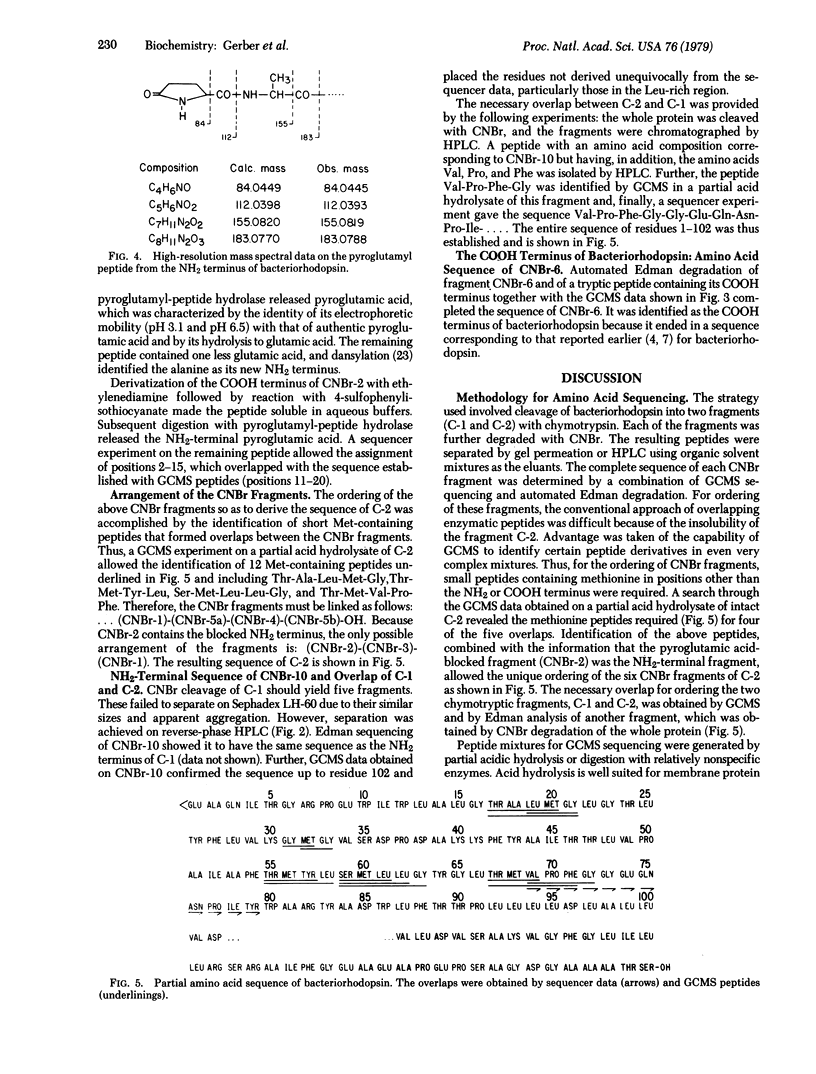Abstract
The sequence of 102 amino acid residues from the NH2 terminus and that of 39 amino acid residues from the COOH terminus of bacteriorhodopsin have been determined. These results are in agreement with those recently published by Ovchinnikov and coworkers [Ovchinnikov, Y.A., Abdulaey, N.G., Feigina, M.Y., Kiselev, A.V. & Lobanov, N.A. (1977) FEBS Lett. 84, 1-4]. Chymotryptic cleavage of bacteriorhodopsin produced two fragments, C-1 (Mr 19,000) and C-2 (Mr 6900), the latter containing the blocked NH2 terminus (pyroglutamic acid). Further fragmentation with CNBr gave mostly hydrophobic fragments, which were separated by gel permeation and reverse-phase high-pressure liquid chromatography in formic acid/ethanol/water mixtures. The fragments were sequenced by a judicious combination of mass spectrometric peptide sequencing and automated Edman degradation. The C-2 fragments were ordered on the basis of methionine-containing peptides identified by gas chromatographic mass spectrometry, while C-1 and C-2 were arranged by analysis of an overlapping CNBr fragment.
Full text
PDF




Selected References
These references are in PubMed. This may not be the complete list of references from this article.
- BREITENBACH J. W., DERKOSCH J., WESSELY F. Energetics of peptide formation. Nature. 1952 May 31;169(4309):922–922. doi: 10.1038/169922a0. [DOI] [PubMed] [Google Scholar]
- Bailey G. S., Gillett D., Hill D. F., Petersen G. B. Automated sequencing of insoluble peptides using detergent. Bacteriophage fl coat protein. J Biol Chem. 1977 Apr 10;252(7):2218–2225. [PubMed] [Google Scholar]
- Bridgen J., Walker I. D. Photoreceptor protein from the purple membrane of Halobacterium halobium. Molecular weight and retinal binding site. Biochemistry. 1976 Feb 24;15(4):792–798. doi: 10.1021/bi00649a010. [DOI] [PubMed] [Google Scholar]
- Bridgen P. J., Cross G. A., Bridgen J. N-terminal amino acid sequences of variant-specific surface antigens from Trypanosoma brucei. Nature. 1976 Oct 14;263(5578):613–614. doi: 10.1038/263613a0. [DOI] [PubMed] [Google Scholar]
- Gerber G. E., Gray C. P., Wildenauer D., Khorana H. G. Orientation of bacteriorhodopsin in Halobacterium halobium as studied by selective proteolysis. Proc Natl Acad Sci U S A. 1977 Dec;74(12):5426–5430. doi: 10.1073/pnas.74.12.5426. [DOI] [PMC free article] [PubMed] [Google Scholar]
- Henderson R., Unwin P. N. Three-dimensional model of purple membrane obtained by electron microscopy. Nature. 1975 Sep 4;257(5521):28–32. doi: 10.1038/257028a0. [DOI] [PubMed] [Google Scholar]
- Keefer L. M., Bradshaw R. A. Structural studies on Halobacterium halobium bacteriorhodopsin. Fed Proc. 1977 May;36(6):1799–1804. [PubMed] [Google Scholar]
- Klapper D. G., Wilde C. E., 3rd, Capra J. D. Automated amino acid sequence of small peptides utilizing Polybrene. Anal Biochem. 1978 Mar;85(1):126–131. doi: 10.1016/0003-2697(78)90282-8. [DOI] [PubMed] [Google Scholar]
- Nau H., Biemann K. Amino acid sequencing by gas chromatography--mass spectrometry using trifluoro-dideuteroalkylated peptide derivatives. C. The primary structure of the carboxypeptidase inhibitor from potatoes. Anal Biochem. 1976 May 21;73(1):175–186. doi: 10.1016/0003-2697(76)90152-4. [DOI] [PubMed] [Google Scholar]
- Oesterhelt D. Bacteriorhodopsin as an example of a light-driven proton pump. Angew Chem Int Ed Engl. 1976 Jan;15(1):17–24. doi: 10.1002/anie.197600171. [DOI] [PubMed] [Google Scholar]
- Oesterhelt D., Stoeckenius W. Rhodopsin-like protein from the purple membrane of Halobacterium halobium. Nat New Biol. 1971 Sep 29;233(39):149–152. doi: 10.1038/newbio233149a0. [DOI] [PubMed] [Google Scholar]
- Ovchinnikov Y. A., Abdulaev N. G., Feigina M. Y., Kiselev A. V., Lobanov N. A. Recent findings in the structure-functional characteristics of bacteriorhodopsin. FEBS Lett. 1977 Dec 1;84(1):1–4. doi: 10.1016/0014-5793(77)81046-6. [DOI] [PubMed] [Google Scholar]
- Swank R. T., Munkres K. D. Molecular weight analysis of oligopeptides by electrophoresis in polyacrylamide gel with sodium dodecyl sulfate. Anal Biochem. 1971 Feb;39(2):462–477. doi: 10.1016/0003-2697(71)90436-2. [DOI] [PubMed] [Google Scholar]
- Szewczuk A., Kwiatkowska J. Pyrrolidonyl peptidase in animal, plant and human tissues. Occurrence and some properties of the enzyme. Eur J Biochem. 1970 Jul;15(1):92–96. doi: 10.1111/j.1432-1033.1970.tb00980.x. [DOI] [PubMed] [Google Scholar]
- Tomita M., Marchesi V. T. Amino-acid sequence and oligosaccharide attachment sites of human erythrocyte glycophorin. Proc Natl Acad Sci U S A. 1975 Aug;72(8):2964–2968. doi: 10.1073/pnas.72.8.2964. [DOI] [PMC free article] [PubMed] [Google Scholar]
- Weiner A. M., Platt T., Weber K. Amino-terminal sequence analysis of proteins purified on a nanomole scale by gel electrophoresis. J Biol Chem. 1972 May 25;247(10):3242–3251. [PubMed] [Google Scholar]
- Wickner W. Asymmetric orientation of phage M13 coat protein in Escherichia coli cytoplasmic membranes and in synthetic lipid vesicles. Proc Natl Acad Sci U S A. 1976 Apr;73(4):1159–1163. doi: 10.1073/pnas.73.4.1159. [DOI] [PMC free article] [PubMed] [Google Scholar]


